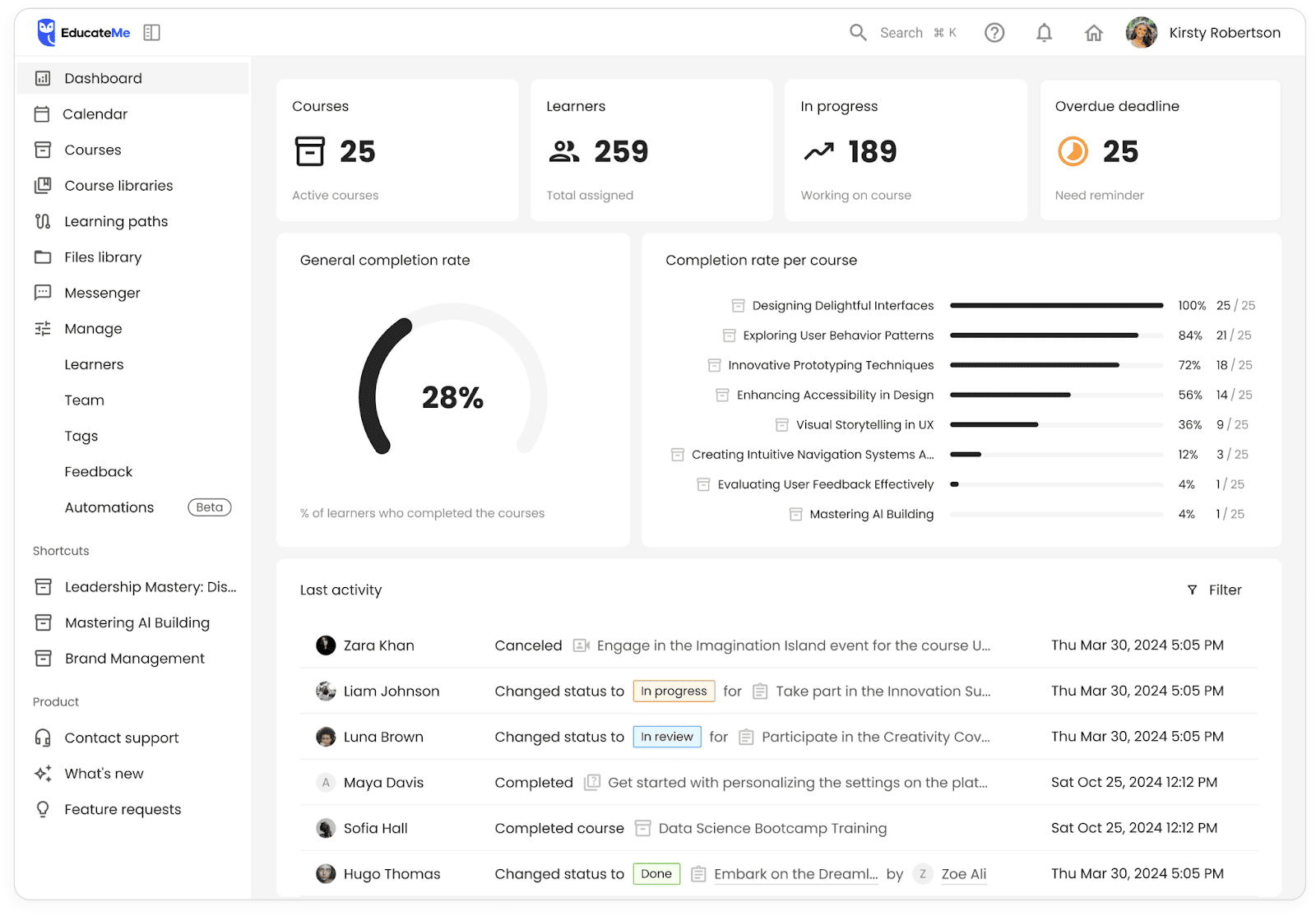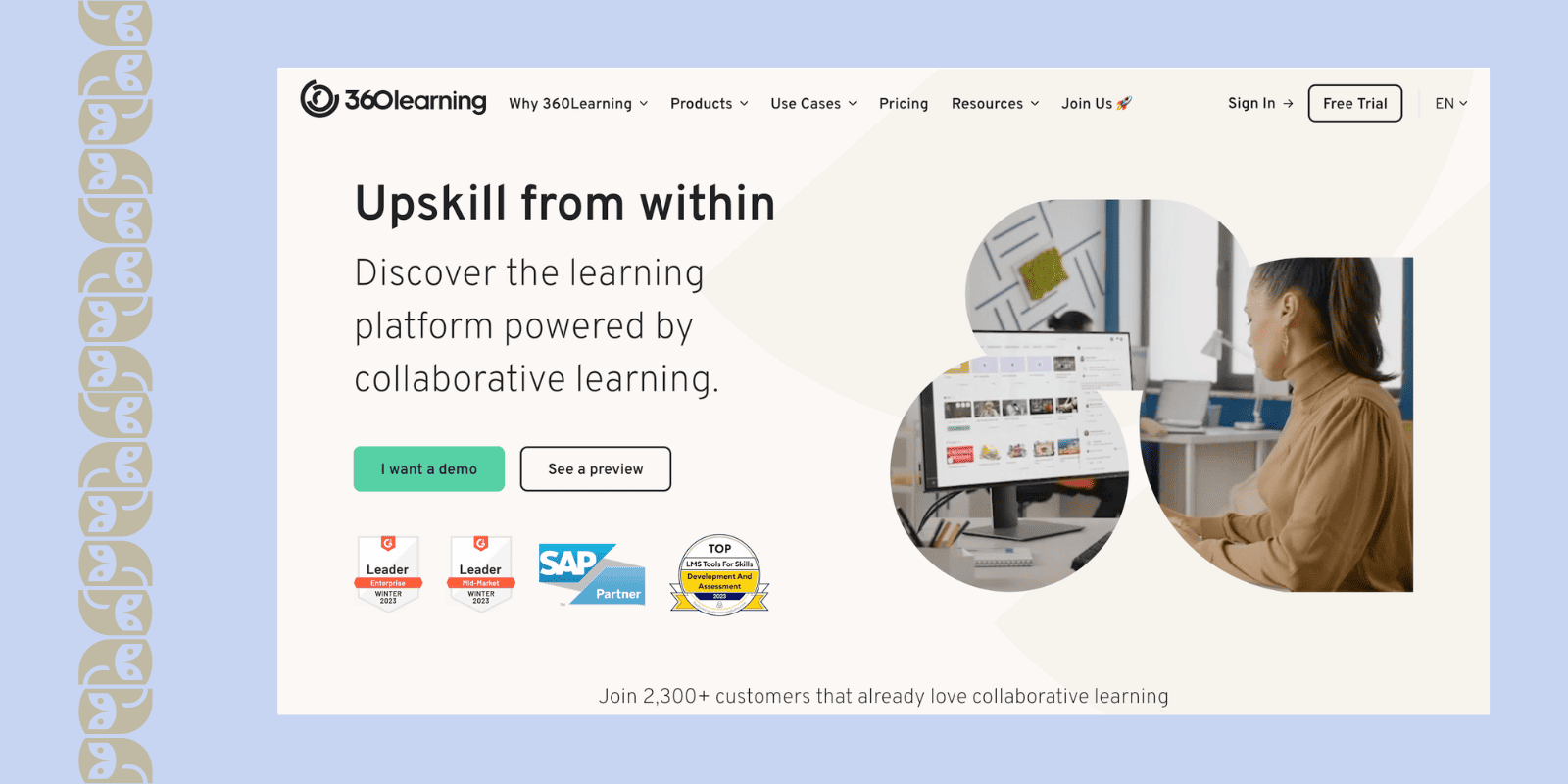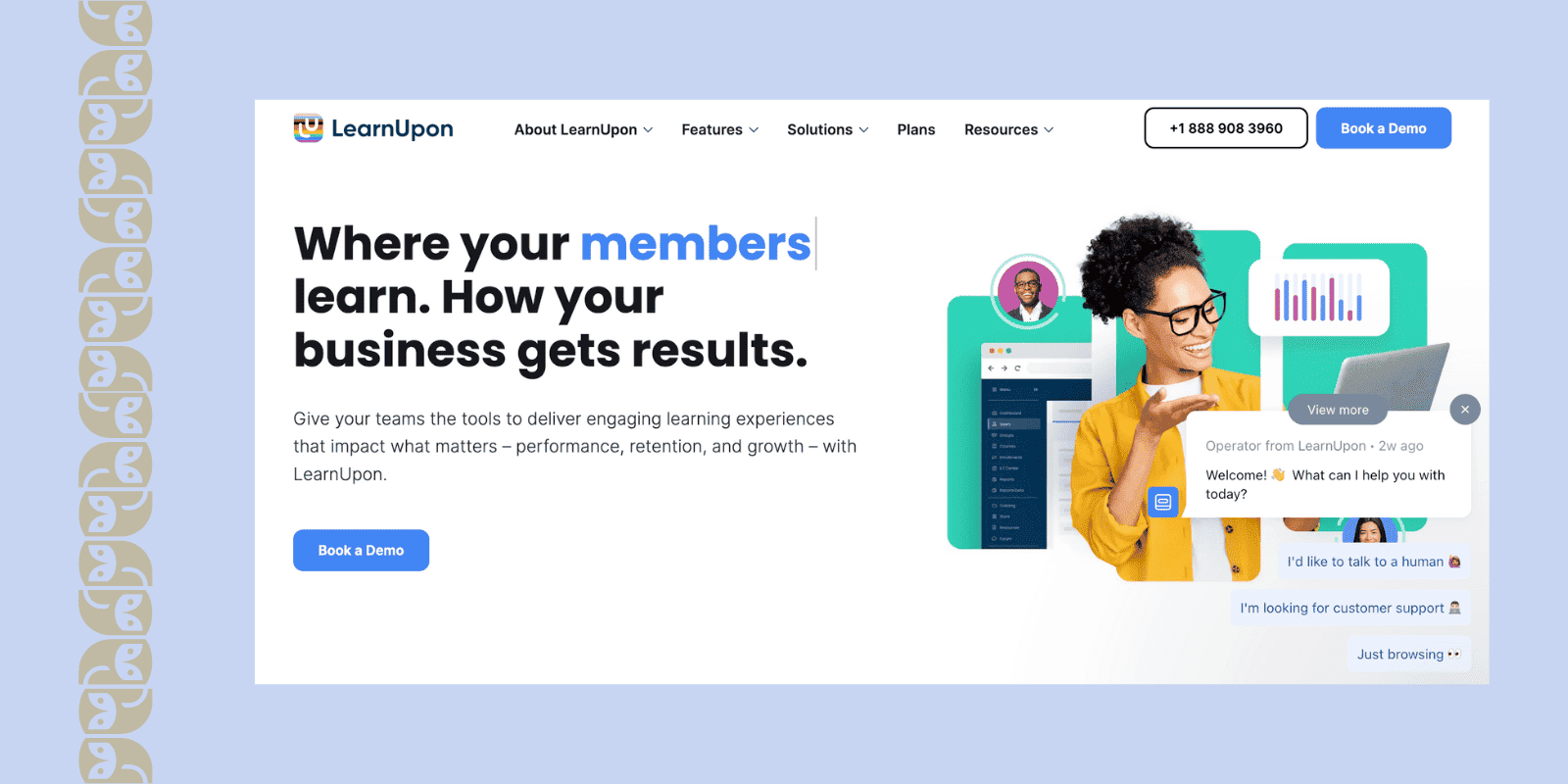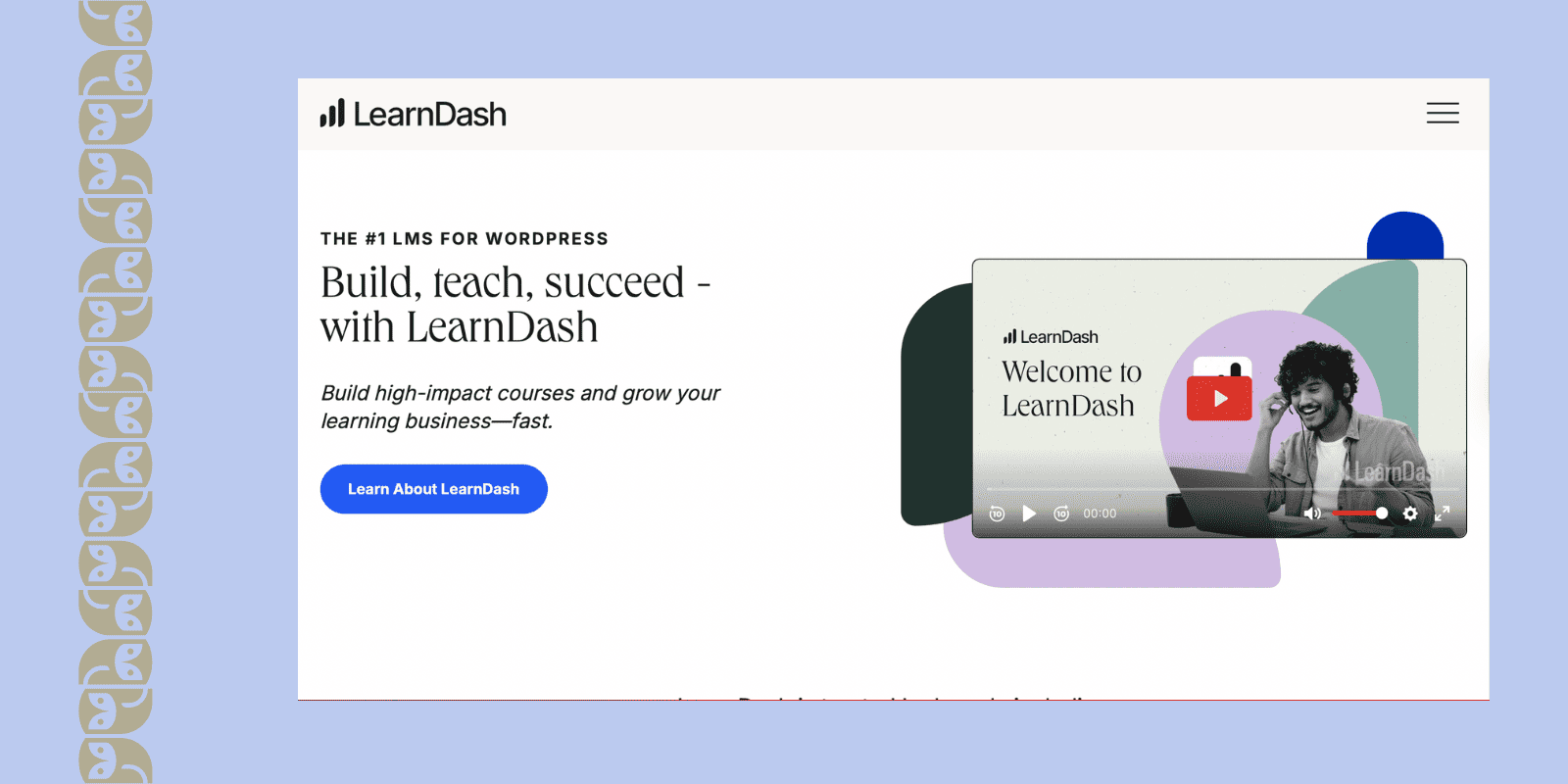f you have any exposure to online education, you're likely acquainted with the concept of blended learning. In recent times, this approach has emerged as a pivotal component within the L&D strategies, corporate learning, and employee training.
But what exactly does it entail? In this discussion, we'll delve into the essence of blended learning and examine what blended learning platforms can facilitate the seamless integration of blended learning methodologies.
What is Blended Learning?
Blended learning is a methodology that harnesses educational technology to seamlessly integrate various learning formats, spanning from traditional face-to-face instruction to electronic mediums.
Students following this approach have the autonomy to choose when, where, and at what pace they engage with learning material, enabling them to balance learning with other commitments like work.
This educational model, also known as integrated learning, often incorporates a mix of in-person classes, hands-on activities, self-directed study, and online components, creating a dynamic learning environment.
While blending online learning with teacher-led instruction empowers students to take a more active role in their education and apply newfound knowledge in real-world scenarios, it also caters to those who thrive on interpersonal interaction in a classroom setting.
Thus, blended education serves as a pragmatic solution, bridging the gap between traditional and digital learning paradigms while preserving the merits of both approaches.
Benefits of Blended Learning
1. Meeting the needs of all students
Blended learning technology seamlessly caters to diverse learning preferences, whether students thrive in group settings or prefer solitary study, face-to-face instruction, or online learning environments.
Unlike traditional education settings or strictly online courses, integrated educational technologies offer flexibility that can be tailored to the specific discipline, module, and individual student needs. While not all courses may naturally lend themselves to digital learning formats, incorporating interactive elements and online components can enhance engagement and accessibility.
💡Further Reading: Guide For Creating A Collaborative Learning Environment in 2025
2. Training trends and feedback
By integrating online and offline technologies, educators can swiftly adopt and implement new educational tools and methodologies into the curriculum. For instance, specialized tools and programs enable teachers to track student progress and provide targeted feedback, fostering continuous improvement and personalized learning experiences.
Blended learning empowers students to actively engage with course material, fostering the practical application of newly acquired skills within a supportive environment. This hands-on approach not only enhances comprehension but also fosters a deeper understanding of the subject matter, ultimately enriching the learning experience.
3. Fun and participation
Blended learning offers an interactive learning experience, granting students autonomy to choose the content they engage with and how they tackle assignments. Constant interaction with peers and instructors facilitates dynamic discussions, idea-sharing, and collaborative learning, enhancing comprehension and retention.
Collaborative experiences in blended learning environments foster student engagement and enable educators to pinpoint areas requiring further attention or clarification, promoting a more inclusive and effective learning environment.
💡Further Reading: How To Create Interactive Online Training Program: [Full Guide]
4. Reach and Personalization
Blended learning transcends geographical barriers and caters to learners of all ages and educational backgrounds. Educational programs are personalized to meet individual student needs, eliminating redundancy and ensuring students focus on acquiring new knowledge and skills.
Often likened to a "buffet," blended learning empowers each student to navigate their learning journey at their own pace and style, fostering a sense of autonomy and ownership that accelerates learning outcomes. This adaptable, relaxed format enhances the efficiency and effectiveness of the learning process.

What is Blended Learning Platform?
A blended learning platform combines online modules with live, in-person sessions to give employees a flexible learning experience. It allows workers to access training materials at their own pace, while still benefiting from face-to-face workshops or coaching sessions.
Blended learning platforms make it easier for businesses to provide consistent, on-the-job training without requiring employees to leave their workstations for long periods.
Must-Have Blended Learning Platform Features
Now it's time to depict the most important hybrid learning management system features for blended learning.
1. Access to learning materials through different devices. As a responsible for the implementation of blended learning, you'll appreciate the flexibility this feature offers your employees. They can access course materials on various devices, ensuring they can learn on the go, whether they're in the office, at home, or on the move.
2. Integration with various software. Imagine streamlining your company's workflows with seamless integration between your LMS for blended learning and other essential software tools. From HR systems to project management platforms, this integration ensures a cohesive learning experience, maximizing efficiency and productivity across your organization.
3. Learner enrollment and management tools. Simplify the process of enrolling employees in courses and managing their progress with intuitive tools. From tracking completion rates to monitoring skill development, these tools empower you to effectively oversee your company's learning initiatives, ensuring everyone stays on track toward their professional development goals.
4. Features for synchronous and asynchronous learning. Catering to diverse learning preferences and schedules is crucial for a successful blended learning approach. With features supporting both synchronous, real-time interactions and asynchronous, self-paced learning, you can provide flexibility while maintaining engagement and collaboration among your workforce.
5. Tools for learner communication and collaboration. Foster a culture of collaboration and knowledge sharing among your employees with robust communication tools. From discussion forums to virtual group projects, these features facilitate peer-to-peer learning and collaboration, enhancing the overall effectiveness of your training programs.
6. Learner engagement features and gamification options. Keep your employees motivated and engaged in their learning journey with gamification elements and interactive features. By incorporating badges, leaderboards, and rewards, you can boost participation and drive continuous learning, ultimately contributing to a more engaged and skilled workforce.
7. Grading, analytics, and progress tracking tool. Gain valuable insights into your company's learning outcomes and employee performance with comprehensive grading, analytics, and progress-tracking tools. By monitoring key metrics and analyzing data, you can measure the impact of your training initiatives, identify areas for improvement, and make informed decisions to optimize your blended learning strategy.
Alright, let's get into best LMS blended learning. We've thoroughly examined each of the top blended platform for 2025, focusing on key features, including:
- accessibility;
- integration;
- learner management;
- content creation;
- flexibility;
- collaboration & engagement tools;
- customization;
- support resources.
After careful evaluation, we're prepared to share our insights and recommendations with you.
#1. EducateMe — Best Blended Learning Platform Overall

EducateMe is a premier blended learning platform, offering a dynamic environment and facilitating seamless integration of various learning modalities, fostering an engaging and interactive educational experience.
With seamless integration of various learning modalities, real-time reporting on learner engagement, and a delectable array of content creation options (including AI-powered course creation) EducateMe ensures an engaging and interactive educational experience. Plus, with customizable branding options, round-the-clock customer support, and automated engagement tools, it's the perfect recipe for both corporate training programs and educational institutions seeking the blended learning solution.
Relevant Blended Learning Features
- Accessibility: Fully responsive, and user-friendly interface.
- Integration: Zoom (with automatic record saving), Notion, Loom, Google Calendar, Stripe, Embedding Materials (from Figma, Google Suite, Calendly, etc.), and APIs.
- Learner management: Easy invitation via email or link, seamless import from CSV files, and convenient assignment through tagging; automated assignments, grading, and feedback management; completion rules; assign permissions; group segmentation; real-time notifications; unified assignment dashboard; cohort management; automated learner enrollment.
- Reporting: Real-time reports on learner engagement, progress tracking, and course effectiveness; report exports; dynamic dashboards; tagging & sorting; 'red-flag' feature to identify and support the least engaged learners.
- Content creation: Manual, AI-powered, template-based course creation; course duplication feature; modules, lessons, webinars, quizzes, assignments; bite-sized content; drip scheduling; drag & drop interface; embedding content; on-demand video.
- Flexibility: Synchronous and asynchronous learning environment. Deadline management; relative due dates; automatic calendar update; automatic time zone management.
- Collaboration & engagement: Built-in messenger; peer review; group assignments supported by the Kanban board.
- Customization: custom fonts, colors, logo, button shapes, domain, menu for learners; personalized sign-up and log-in form.
- Support resources: Help Center; Changelogs; Interactive Video Tutorials; 24/7 Customer Support.
Best For: Ideal choice for both corporate training programs and educational institutions implementing blended learning models.
#2. 360 Learning — Best Blended Learning LMS with Mobile App

360Learning is the blended learning LMS with a mobile application, offering a robust platform for crafting training programs through a seamless integration of online and offline training methodologies.
With its mobile application, you get access to establish a mobile-first learning approach that enhances engagement and flexibility. They offer a comprehensive suite of features, including integration with popular tools, customizable learner management, and dynamic collaboration tools, ensuring an effective and impactful learning experience for all users.
Relevant Blended Learning Features
- Accessibility: Fully responsive, and user-friendly interface; mobile application for learners.
- Integration: Zoom, Google Drive, Salesforce, Slack; Canva; MS Teams; Big-commerce; HCM/HRIS sync; SSO.
- Learner management: Users one-by-one import, CSV import or users self-registration; user data synchronization with HCM or HRIS platform; assign permissions; group segmentation; unlimited custom user fields; customized & automated reports; report exports; cohort management; automated learner enrollment; automated notifications; certificates.
- Content creation: Course templates; web-based files embedding; surveys; AI suggest custom quizzes; course duplication; integrated video recorder; co-authors; AI-powered authoring; course versioning;
- Flexibility: Synchronous and asynchronous learning environment. Offline mode; bulk import; language manager; customized linear or non-linear paths; flexible course order; relative due dates.
- Collaboration & engagement: Virtual classrooms; screencast demo; newsfeed; forum; upvotes & sharing; badges; leaderboard; achievements.
- Customization: Custom colors and fonts; personalized banner images; welcome messages; email invitations; reaction images; color-branded buttons and menu.
- Support resources: Knowledge Base; Release Notes; Customer Support.
Pricing: 30-day free trial; Team Plan — $8/registered user per month (up to 100 users/month); Business Plan — custom price.
Best For: Well-suited for businesses and enterprises aiming to enhance employee training and development programs with mobile first learning accent.
#3. TalentLMS — Best Blended Learning Software with Gamification

TalentLMS is one of the top blended learning platforms, offering gamification opportunities alongside comprehensive features, ideal for creating engaging and effective training experiences.
With seamless integration with tools like Zoom and Salesforce, it streamlines the training process, allowing for efficient management of learners and customizable learning paths tailored to individual needs. Its dynamic collaboration tools, including video conferences and discussion forums, foster a sense of community and active engagement among learners, maximizing knowledge retention and application. Furthermore, TalentLMS's commitment to accessibility and scalability, coupled with its range of pricing plans catering to various budgets.
Relevant Blended Learning Features
- Accessibility: Fully responsive, and user-friendly interface.
- Integration: Zoom; MS Teams; Salesforce; Google Analytics; MailChimp; Slack; Trello; PayPal; Stripe; Google Calendar; Zapier; SSO; HRIS.
- Learner management: Import users in bulk, self-register, and sync accounts from other systems; roles and permissions; detailed learning paths; completion rules; custom certificates; automatic emails; auto-assign and remove courses; expiration dates; course sequencing; automatic deactivation of inactive users; real-time, scheduled, and custom reports; dynamic dashboards; training infographics; exportable Excel sheets.
- Content creation: Drag and drop course builder; quizzes, tests, assignments, and surveys; AI-powered course creation assistant.
- Flexibility: Synchronous and asynchronous learning environment. 30 languages support; automatic time zone management; offline mode.
- Collaboration & engagement: Video conferences; discussion forums; badges, points, levels, leaderboards, and rewards.
- Customization: Custom logo, brand colors, domain; custom HTML, CSS, and JavaScript; personalized training homepage.
- Support resources: Knowledge Base; Product News; Video Tutorials; Live Chat Support (Premium Plan).
Pricing: forever-free plan with up to 10 courses and up to 5 users; Starter Plan — $69 /m with unlimited courses & custom homepage; Basic — $149/m with SSO support & custom domain + SSL; Plus — $279/m with Custom reports; Premium — $459/m with Account manager, automation and live chat support.
Best For: Businesses and educational institutions aiming to create engaging and interactive training experiences.
#4. iSpring Learn — Best Easy-to-Use Blended Learning Platform

iSpring Learn LMS excels as a top LMS for blended learning, offering unparalleled ease of use alongside robust features, making it effortless to create dynamic and effective learning programs.
Its seamless integration with popular platforms like MS Teams and Zoom ensures a smooth transition to blended learning. The ability to customize the platform with your branding adds a professional touch, while dedicated tech support ensures you have assistance every step of the way.
Relevant Blended Learning Features
- Accessibility: Fully responsive, and user-friendly interface. Mobile Application.
- Integration: MS Teams; Zoom; Salesforce; Bitrix24; Shopify; MS Outlook; HRIS; API; SSO.
- Learner management: one-by-one invitation or XLSX files import; filter for assigning courses users; automatic assignments; content reports; people reports; quiz and simulation reports; e-mail notifications; 360-degree feedback; points, badges & leaderboards.
- Content creation: courses, assessments, role-plays, dialog simulations, video lessons, long reads, quizzes, and surveys; unlimited storage space; step-by-step navigation; free-form assignments.
- Flexibility: Synchronous and asynchronous learning environment. Support of all languages; free mobile application; on-premise installation opportunity.
- Collaboration & engagement: Award points, badges, and certificates.
- Customization: Brand colors and fonts; customized logo and favicon; language customization.
- Support resources: Dedicated tech support; Knowledge Base (Help Docs, Guides, FAQ; Webinars).
Pricing: Start Plan — 50 users: $2.99; 100 users: $2.87; 300: $2.29 per user/month, billed annually. Business Plan — 300 users: $3.14; 500: $2.89; 1000 users: $2.55 per user/month, billed annually.
Best For: Businesses and educational institutions looking to effortlessly implement dynamic and effective learning programs.
#5. SafetyCulture — Best Free Blended Learning LMS

SafetyCulture is the good choice for organizations seeking a free blended learning solution, offering comprehensive features, an intuitive interface, and robust analytics.
Its comprehensive content creation tools include an AI course creator and over 80 templates, while providing flexibility with synchronous and asynchronous learning environments. They can boast about AI translation into 100+ languages, and collaborative features like discussion forums and peer authoring.
Relevant Blended Learning Features
- Accessibility: Fully responsive, and user-friendly interface.
- Integration: G-Suite; Microsoft; Canva; BambooHR; Xero; Deputy; SSO; Zapier; Public API; SCORM and AICC Import / Export.
- Learner management: Registration via invite links or via bulk CSV upload; user groups; custom performance and engagement reports; in-person attendance; video conferencing; paths, access dates, and mandatory courses control; simple link or QR code;
- Content creation: AI course creator; 80+ course templates; video, quizzes, games, assessments; editable course library; bite-sized content; course creation services; PowerPoint into course converter; quiz maker.
- Flexibility: Synchronous and asynchronous learning environment. AI Translation into 100+ languages; offline mode;
- Collaboration & engagement: In-build games; achievements; real reward; spaced repetition; push notifications; certificates; assignments; discussion forum; Brain Boost spaced repetition tool; stars & prizing draws; peer authoring;
- Customization: Background, button, progress indication color scheme; fonts; logo; custom CSS; preview mode.
- Support resources: Live chat; Help Center; onboarding bootcamp.
Pricing: Free Plan — unlimited number of lessons and unlimited users; Do it yourself — $2.95 per active user/month; Managed — $2.95-$5.95 per user/ month; Enterprise — custom pricing.
Best For: Ideal platform for implementing dynamic training programs without financial constraints.
#6. LearnUpon – Blended Learning LMS with Personalized Learning Portals

LearnUpon stands out for its advanced personalization capabilities, making it an excellent choice for organizations looking to create tailored learning experiences. This LMS is designed to offer customized learning portals for different user groups, ensuring that each learner receives content and resources that are relevant to their needs.
Relevant Blended Learning Features
- Accessibility: Fully responsive design; mobile application.
- Integration: Supports popular tools such as Zoom, Salesforce, Google Analytics, and various HRIS systems.
- Learner Management: Advanced user segmentation; custom learner portals; bulk user import; automated notifications; detailed reporting.
- Content Creation: Drag-and-drop course builder; extensive template library; multimedia content support; SCORM and Tin Can API compatibility.
- Flexibility: Supports both synchronous and asynchronous learning; offline access; adaptive learning paths.
- Collaboration & Engagement: Discussion forums; social learning features; group projects; gamification elements.
- Customization: Custom branding; personalized learning portals; role-based access; white-label options.
- Support Resources: Comprehensive Help Center; live chat support; dedicated account manager (for premium plans).
Pricing: Custom pricing based on organizational size and requirements.
Best For: Organizations looking for a highly customizable LMS that can deliver personalized learning experiences across various user groups.
#7. Moodle – Best Open Source LMS for Blended Learning

Moodle remains a top choice for those seeking an open-source solution with extensive flexibility and customization options. Known for its robustness and extensive community support, Moodle offers a versatile platform for integrating blended learning models in both educational and corporate settings.
Relevant Blended Learning Features
- Accessibility: Fully responsive; customizable themes; mobile app available.
- Integration: Extensive plugin ecosystem; integration with Google Drive, Microsoft Office 365, and various third-party tools.
- Learner Management: Comprehensive user management; advanced reporting tools; automated enrollment and notifications.
- Content Creation: Powerful course management tools; SCORM and H5P support; customizable content formats; drag-and-drop course builder.
- Flexibility: Supports synchronous and asynchronous learning; extensive customization options for course design.
- Collaboration & Engagement: Forums; wikis; chat; peer assessment; collaborative assignments.
- Customization: Open-source flexibility allows extensive customization; custom plugins and themes; white-labeling options.
- Support Resources: Community forums; detailed documentation; various support tiers available through Moodle Partners.
Pricing: Free (open-source); costs associated with hosting, customization, and support services.
Best For: Institutions and organizations seeking a flexible, customizable LMS with strong community support and the ability to adapt to specific blended learning needs.
#8. LearnDash — Best Blended Learning LMS for WordPress

LearnDash integrates seamlessly with WordPress, making it an ideal choice for organizations already utilizing this popular CMS platform. It provides powerful features for creating and managing blended learning experiences within a familiar environment.
Relevant Blended Learning Features
- Accessibility: Fully responsive; integrates with WordPress themes and plugins.
- Integration: Works with various WordPress plugins; integration with tools like Zapier, WooCommerce, and various email marketing platforms.
- Learner Management: Advanced user management; detailed reporting; automated course assignments; engagement tracking.
- Content Creation: Drag-and-drop course builder; multimedia support; quizzes and assignments; drip-feed content functionality.
- Flexibility: Synchronous and asynchronous learning support; flexible course scheduling; extensive customization options.
- Collaboration & Engagement: Discussion forums; social learning; group-based assignments; gamification elements.
- Customization: Full WordPress integration allows extensive theme and plugin customization; white-labeling options.
- Support Resources: Knowledge base; community forums; premium support options available.
Pricing: Starting at $199 per year for a single site; pricing scales based on the number of sites and features.
Best For: WordPress users looking for a powerful, integrated LMS solution that leverages their existing CMS platform for blended learning.
#9. Absorb LMS — Best Blended Learning for Upskilling

Absorb LMS is tailored for organizations focused on employee development and upskilling. This blended learning software offers a comprehensive set of features designed to enhance learning efficiency and effectiveness, making it a top choice for corporate training programs.
Relevant Blended Learning Features
- Accessibility: Fully responsive; mobile application.
- Integration: Integrates with a range of HRIS, CRM, and productivity tools such as Salesforce, Slack, and Microsoft Teams.
- Learner Management: Advanced learner analytics; automated course assignments; progress tracking; certification management.
- Content Creation: Course builder with multimedia support; SCORM and Tin Can API compliance; extensive content library.
- Flexibility: Supports synchronous and asynchronous learning; adaptive learning paths; offline mode.
- Collaboration & Engagement: Virtual classrooms; social learning features; discussion boards; gamification.
- Customization: Custom branding; role-based access control; flexible course design options.
- Support Resources: Dedicated customer support; extensive knowledge base; training resources.
Pricing: Custom pricing based on organizational needs and scale.
Best For: Companies focusing on upskilling their workforce with a comprehensive and scalable blended learning solution.
#10. LearnWorlds — Best Blended LMS Powered by AI

LearnWorlds distinguishes itself with advanced AI-powered features designed to enhance the learning experience and improve engagement. It’s ideal for organizations looking to leverage cutting-edge technology in their blended learning strategies.
Relevant Blended Learning Features
- Accessibility: Fully responsive; mobile app.
- Integration: Integrates with popular tools such as Zapier, Google Analytics, and various CRM systems.
- Learner Management: AI-powered analytics; custom reporting; automated learner tracking; personalized learning journeys.
- Content Creation: AI-driven course builder; interactive video; extensive template library; multimedia support.
- Flexibility: Synchronous and asynchronous learning; AI translation into multiple languages; offline access.
- Collaboration & Engagement: Gamification; social learning tools; interactive quizzes; discussion forums.
- Customization: Custom branding; course customization; dynamic content options.
- Support Resources: 24/7 customer support; knowledge base; video tutorials.
Pricing: Starting at $29 per month; pricing varies based on features and scale.
Best For: Organizations looking to harness AI technology to create engaging, personalized, and adaptive blended learning experiences.
Conclusion
When considering the best platform for implementing blended learning, EducateMe emerges as the clear front-runner. With its seamless integration of various learning modalities, real-time reporting on learner engagement, and customizable content creation options including AI-powered course creation, they offer an engaging and interactive educational experience.
Moreover, its customizable branding options, round-the-clock customer support, and automated engagement tools make it an ideal choice for both corporate training programs and educational institutions seeking a comprehensive blended learning solution.
So, if you're looking for a platform that combines innovation, flexibility, and support, try EducateMe 14-day free trial for your blended learning needs.






















